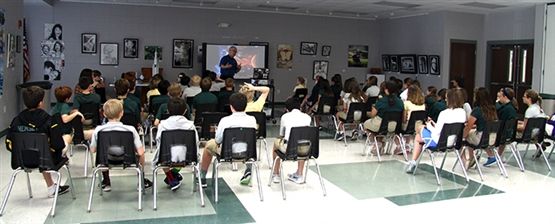

Guest speaker from NASA: Chad Brown
Source/Author: Selene Willis, fifth grade Science Teacher
March 04, 2016
On Thursday, March 3, Shorecrest Middle School had a special speaker from NASA. Mr. Chad Brown, a Lead Flight Integration Engineer, came from the Kennedy Space Center. Addressing the fifth grade first and the rest of the Middle School in a second session, he spoke about the initiative to explore other planets in our solar system.
Fifth grade is in the middle of an Astronomy and Space Science unit, where students are learning the basics of Astronomy and studying similarities between Earth and Mars. The unit will conclude with two projects. First, a debate discussing the question: Should human beings plan to travel to and live on Mars? The second, a collaboration of math, science and technology, where math and science classes will combine to build a possible colony on Mars using Minecraft software.
Mr. Brown’s visit added a real-world perspective to the future of space travel and the challenges NASA and its partners hope to overcome in hopes of one day going to a planet within and beyond our solar system.
Mr. Brown works on the Space Launch System (SLS) launch vehicle in the Ground Systems Development and Operations (GSDO) Program at NASA's Kennedy Space Center in Florida. An SLS is the term used to describe NASA's powerful, advanced launch vehicle for a new era of human exploration beyond Earth’s orbit.
"I am currently participating in the mission planning efforts for sending astronauts to an asteroid, traveling to cislunar space (beyond the moon), a spacecraft to Europa, and of course, sending men and women to Mars. SLS is a real game-changer for space exploration beyond low-Earth orbit!" said Mr. Brown.
With its unprecedented power and capabilities, SLS will launch crews of up to four astronauts in the agency’s Orion spacecraft on missions to explore multiple, deep-space destinations. Offering more payload mass, volume capability and energy to speed missions through space than any current launch vehicle, SLS is designed to be flexible and evolvable and will open new possibilities for payloads, including robotic scientific missions to places like Mars, Saturn and Jupiter.
When asked by a fifth grader what he would take to space if he were to spend a few months in orbit, Mr. Brown replied, "Food, water, fresh clothes, media, communication devices, a power supply, air - of course, the basics. That's the highest priority list."
More about SLS - Click Here
Fifth grade is in the middle of an Astronomy and Space Science unit, where students are learning the basics of Astronomy and studying similarities between Earth and Mars. The unit will conclude with two projects. First, a debate discussing the question: Should human beings plan to travel to and live on Mars? The second, a collaboration of math, science and technology, where math and science classes will combine to build a possible colony on Mars using Minecraft software.
Mr. Brown’s visit added a real-world perspective to the future of space travel and the challenges NASA and its partners hope to overcome in hopes of one day going to a planet within and beyond our solar system.
Mr. Brown works on the Space Launch System (SLS) launch vehicle in the Ground Systems Development and Operations (GSDO) Program at NASA's Kennedy Space Center in Florida. An SLS is the term used to describe NASA's powerful, advanced launch vehicle for a new era of human exploration beyond Earth’s orbit.
"I am currently participating in the mission planning efforts for sending astronauts to an asteroid, traveling to cislunar space (beyond the moon), a spacecraft to Europa, and of course, sending men and women to Mars. SLS is a real game-changer for space exploration beyond low-Earth orbit!" said Mr. Brown.
With its unprecedented power and capabilities, SLS will launch crews of up to four astronauts in the agency’s Orion spacecraft on missions to explore multiple, deep-space destinations. Offering more payload mass, volume capability and energy to speed missions through space than any current launch vehicle, SLS is designed to be flexible and evolvable and will open new possibilities for payloads, including robotic scientific missions to places like Mars, Saturn and Jupiter.
When asked by a fifth grader what he would take to space if he were to spend a few months in orbit, Mr. Brown replied, "Food, water, fresh clothes, media, communication devices, a power supply, air - of course, the basics. That's the highest priority list."
More about SLS - Click Here

















![MS Awards Assembly [Photos, Video] MS Awards Assembly [Photos, Video]](/Images/1px.png?command_1=url&url_1=https%3A%2F%2Fwww.shorecrest.org/userfiles/shpsv2mvc/images/news-images/2025/msawards.JPG&command_2=resize&height_2=85)






